Shopify has been the go-to eCommerce platform for solopreneurs and small-scale businesses since 2006. Today, the platform boasts 3,994,714 websites from over 175 countries. Established giants such as Kylie Cosmetics, LA Lakers, Decathlon, Nestlé, Lindt & Spruengli, and more use Shopify and have built thriving businesses online.
That said, there's a feature on the platform that is free yet left underutilized by most businesses: blogging.
Take a second and think about the following:
- Does your marketing playbook prioritize blogs, or is it all about paid advertising?
- Do blogs get top-billing within your Shopify content marketing strategy?
- How are you monetizing your blogs?
Not leveraging blogs to boost traffic and not improving your Shopify conversion rate is a missed opportunity. If you are looking to kickstart your blogging journey on Shopify, we've got you covered.
In this blog, we've rounded the best Shopify blog examples to get inspiraation from. Let's jump right in.
Top 10 Shopify Blog Examples That'll Get Your Imagination Going
1. Meow Meow Tweet Blog

When you land on the Meow Meow Tweet website, you'll be surprised to see how minimal it is. And one area that stands out is the Blog section. Even though the blogs talk about the Meow Meow Tweet products, they are neither salesy nor pushy.
What you can take away from this example:
- The colorful pictures add vividness and liven up the Blog section
- The Shopify blog theme's user interface is simple to understand and beautifully designed. You can leverage a vast multitude of Shopify apps to multiply store conversion and create a beautiful experience for your end user.
Pro tip: Pay special attention to the content tone and style as it is entertaining (not whimsical) and doubles up as a wonderful light read.
2. Beardbrand

Beardbrand's blog section is a clear winner--not because it has a flashy design (it uses a basic blog template from Shopify), but because it is the perfect example of internal linking within blogs done right.
If you've ever wondered what internal linking looks like in action, Beardbrand's Shopify blog post is a lesson waiting to be learned. Here's how the brand's keyword and interlinking strategy is a cut above the rest:

One, the brand makes use of tactical, revenue-driving keywords (think: "beard oil vs. beard balm," "stages of beard growth," and so on).
Two, the brand's blog is consciously kept organized and clean, with relevant content taking center stage.
Three, the brand's blog is really a repository of user-centric information for anyone who is interested in anything remotely beard-related. To add authority and a professional flavor, the brand is often seen driving expert curations as well as personalized recommendations.
Luckily, there are tools you can leverage, such as Argoid's Shopify product recommendation engine, to personalize product recommendations to the t.
What you can take away from this example:
- Don't take a blanket approach when writing content. If you want to drive engagement and rank high on Google, write for your buyer persona (aka people who are most likely to buy from your brand).
- Strategize your content to build a community of like-minded users to boost brand awareness and affinity.
- Move beyond the cosmetic appeal (think: font choices, imagery, blog design). Ensure that your content is highly focused and has high-quality blog posts, allowing the content to speak for itself.
- Integrate best practices for SEO within your blog posts as effortlessly as Beardbrand does. This means engaging in accurate internal linking, doing thorough and relevant keyword research, and driving off-page SEO techniques to boost your website's organic visitors.
Pro tip: Add a personalized touch to the blog section with a "You might also enjoy…" segment (as Amazon does with its products). You can highlight the most popular blogs to boost readability and increase your reader's time on-site, ultimately allowing you to understand whether visitors find your blogs useful or not.
3. Gymshark

If you want to understand how to create 'helpful, user-friendly' articles instead of mindlessly promoting your products, Fitness apparel retailer, Gymshark is a wonderful case in point.
Titled ‘Gymshark Central,’ the blog is one of the best Shopify blog examples you'll see online, as it is jam-packed with all things related to fitness and training. To add diversity to the posts, you might find the occasional promotional post and 'behind the scenes' type articles:

What makes this blog unique is that even though the topic, 'training' is kind of restrictive for a general audience, this brand takes on a broader approach for exercises and pumps out articles (pun not intended) that are filled with high-quality pictures and gifs.
Additionally, its keyword and SEO game is strong. If you search for 'arm workout' on Google, you will see an article from the brand featured on the first page:

Moreover, the brand does not push its products too much within the articles. Instead, they focus on creating content that is in alignment with the target audience's intent and needs:

What you can take away from this example:
- Focus on offering value to your customer base through your blogs. Do not hard-sell all the time. If required, fit your products naturally within the content flow. A long and drawn-out sales pitch is a complete no-go.
- Target the right keywords and write blogs on specific problems your customers might be facing.
Pro tip: Instead of pushing the apparel, revisit your content topics from a user perspective. For example, instead of talking about gym apparel, think about the various outdoor activities that can be done with the kind of gear Gymshark provides customers and write blogs around this theme.
4. The Farmer's Dog

Let's start with the one thing we don't like about this blog. The blog is titled, 'Digest' which is a phrase most readers/customers might not be familiar with. Plus, there's no mention of the blog section in the top navigation, which can emerge as a hit-and-miss situation for your target audience. Other than that, the pet-food retailer "The Farmer's Dog" ticks off multiple checkboxes for great blog writing:
- One, it uses interesting visuals and imagery to reel the reader in:
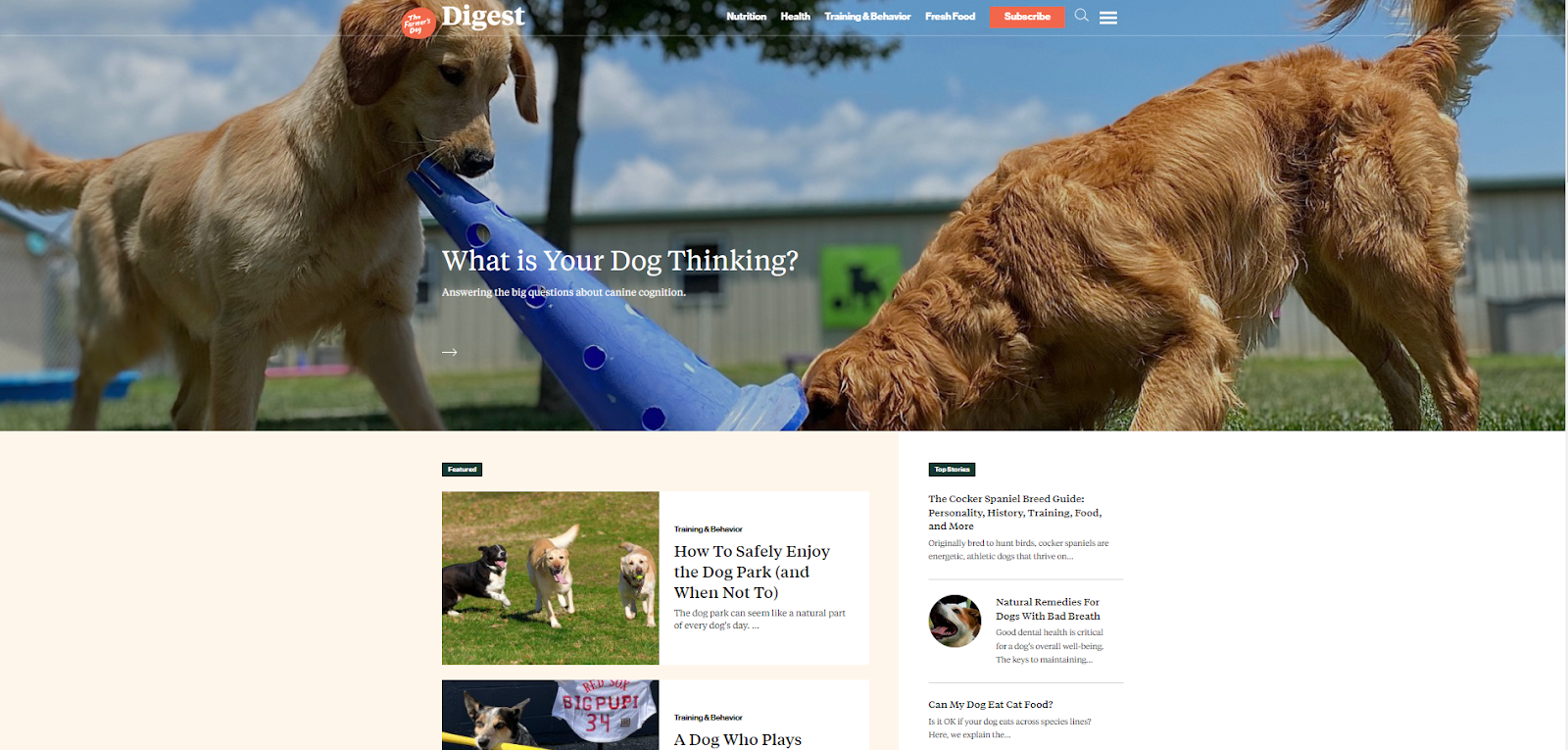
- Two, the blog topics are simple, concise, and above all, relevant to the reader (such as Why Your Dog is Vomiting and What to Do About It, Decoding Your Dog’s Poop, etc.
- Three, it understands that pet owners often turn to Google to learn more about what's going on with their pets when things go south. This is where the blog, ‘Digest’ comes into the picture to help dog owners get all the information they might need in one click.
What you can take away from this example:
- Use relevant, high-quality images to break up the text, elevate the look and feel of your blog, and make it easier for your customers to read. Even if you don't have the luxury or budget to do large-scale photoshoots, you can source great images for free from sites such as Unsplash, as this brand does.
- The biggest plus point of this Shopify blog example is that the posts are authoritative in nature, as they are reviewed for accuracy and are certified by vets. If you want to position your brand as a credible and trustworthy source within your particular niche, this tactic works well.
Pro tip: The content, for the most part, focuses on fostering a long-term relationship with the reader/customer as it provides tons of free advice and useful tips to pet owners. As readers start getting more and more value from the blog posts, they might get tempted to sign up for the brand's free product trial--a win-win for all.
5. Made In
Cookware is not a topic everyone knows a lot about. Plus, given how expensive pots and pans can be, you need an expert to help you assess the pros and cons of the cookware before you zero in on a choice--this is exactly what Made In aims to do via its blog posts. What we love about the blog section is how neatly the content buckets are categorized--from recipes to how to care for your cookware, the brand tries to cover a host of topics:
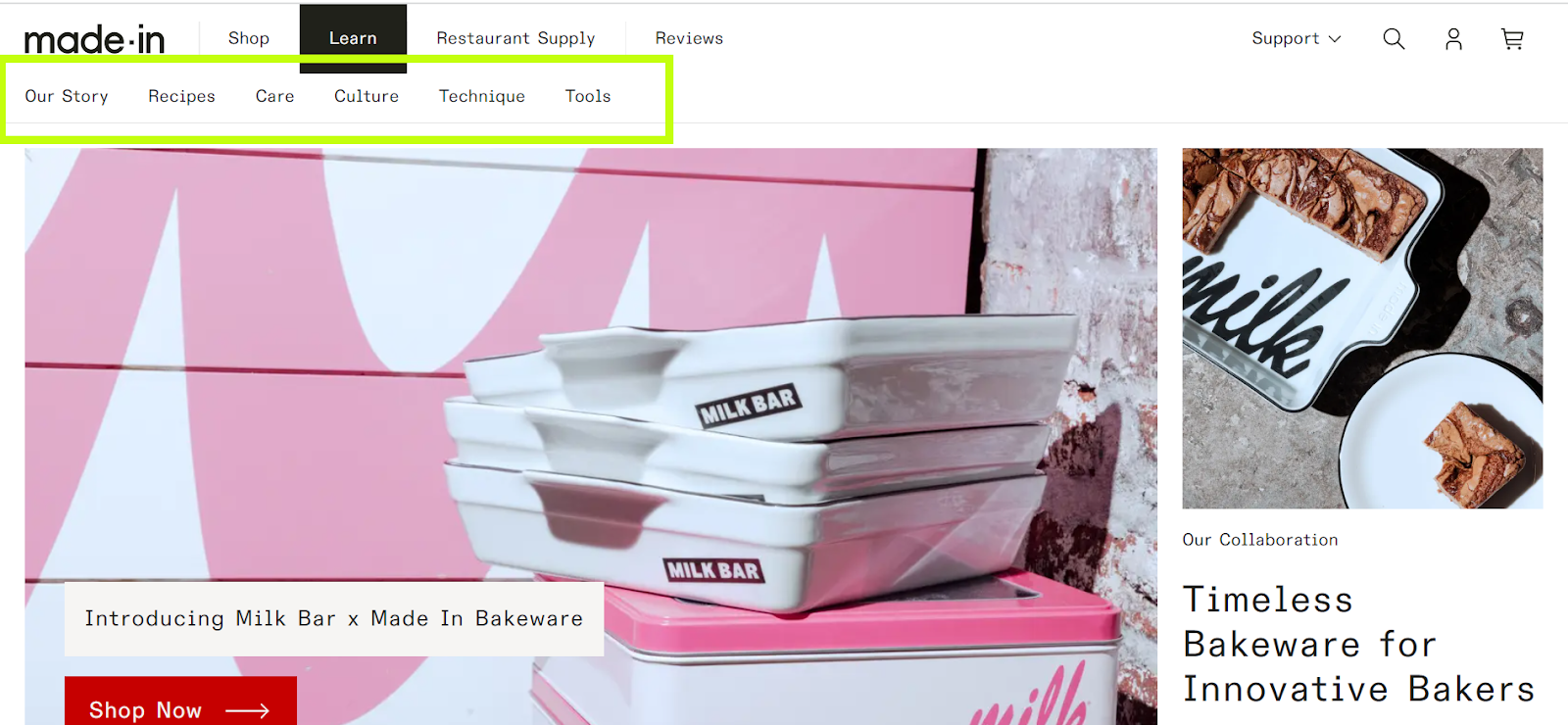
Once you click on a particular tab, you'll be able to see the relevant content with gorgeous images and lots of white space:
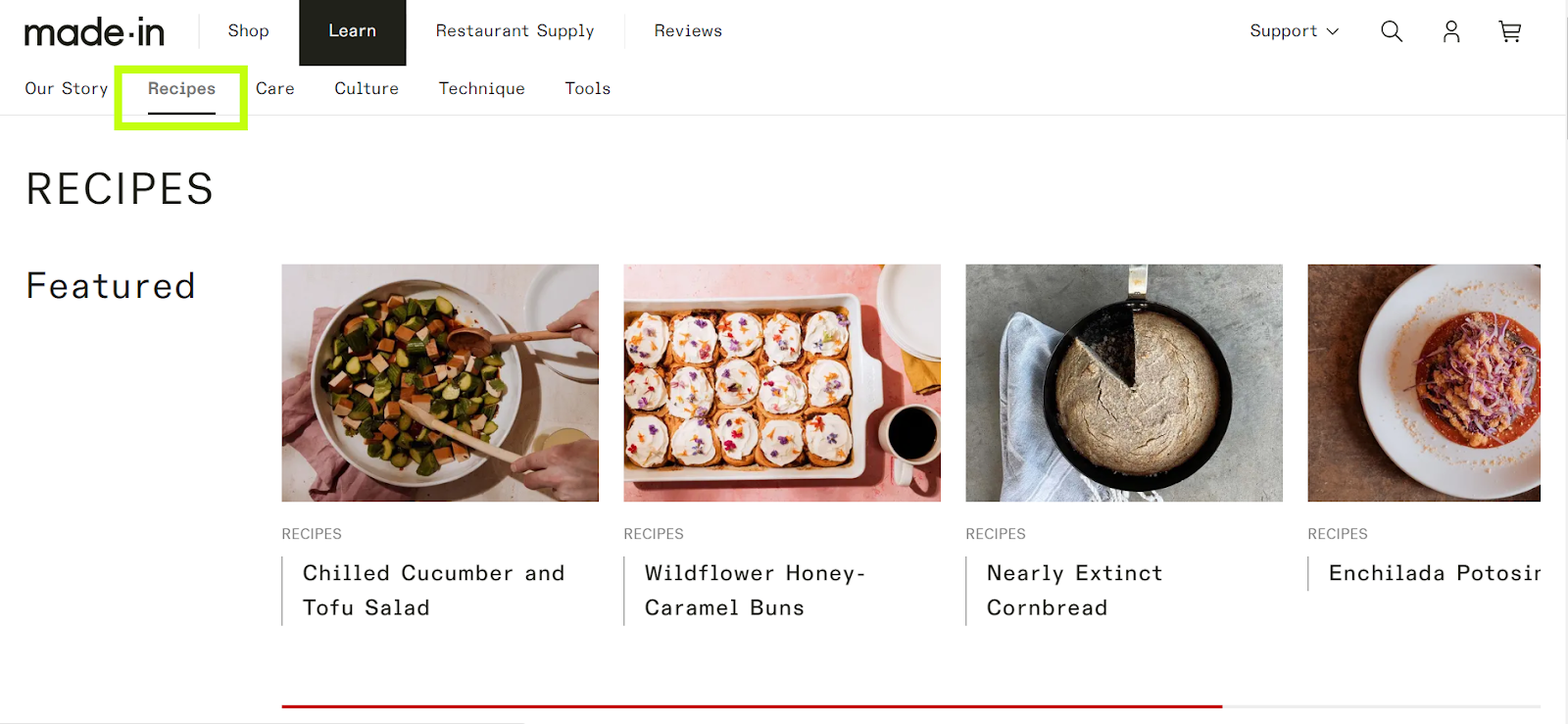
If you want to drive organic traffic to your Shopify storefront, think about ways to build a relationship with your existing customer base:
- Get thinking about posting useful and short "How to" video tutorials within your blogs
- Include tons of pre-vetted recipes, high-profile interviews, and practical care tips within the blog posts
- Talk about the various techniques and kitchen tricks that might be useful for your reader to differentiate your brand from others in the same space
- Most importantly, tell your brand’s story and let customers understand why your brand is more than the products/services it sells. Made In does this by having a dedicated "Culture" section on its blog page where it features real-life chefs and bakers and talks about how all-things cookware and cooking related:

What you can take away from this example:
- If your brand allows, make it a point to constantly collaborate and partner with industry experts and specialists within your product/service space to build unique content for your readers and establish trust. For specialized products/services (such as cookware in this instance), expert-backed content is EVERYTHING!
6. MVMT

According to Forbes, the watch brand MVMT's growth has been nothing short of a miracle, having grown from zero to $60 million in sales in just under four years. And believe it or not, content has played a vital role in this brand's stupendous growth. Here's how:
- One, strategically-conceived content allowed the brand to position itself as a rightful leader in millennial fashion. The brand specifically focuses on go-getters and "people who want to live on their own terms."
- Two, the brand's blog section routinely features collaborations with trending social media influencers (think: @sam_kolder, @ariannahicks, and the like) to capture the audience's interest:

More importantly, the brand does a great job of keeping its tone, style, and content consistent across all the content marketing platforms--be it the blog, the social media content, and more.
- Three, the blog also has an 'Editor's Picks' section, making it easier for customers to get started with reading instead of browsing through hundreds of topics (which can get overwhelming):

What you can take away from this example:
- The biggest learning from this blog is that your blog's aesthetics should align with your website as well as your social media presence to create a cohesive image of the brand, make it look more professional, and drive sales in the process.
- The brand also hits the jackpot as the blog section is heavily-focused on 'Disruptors & Dreamers' or the people who drive it forward. By making the blogs people-centric, the brand is able to humanize itself in the reader's eyes and forge an organic relationship with the reader:

Pro tip: To boost your product in a 'not-so-in-your-face' manner, you can integrate a shoppable Instagram feed at the bottom of your blog section as shown below:
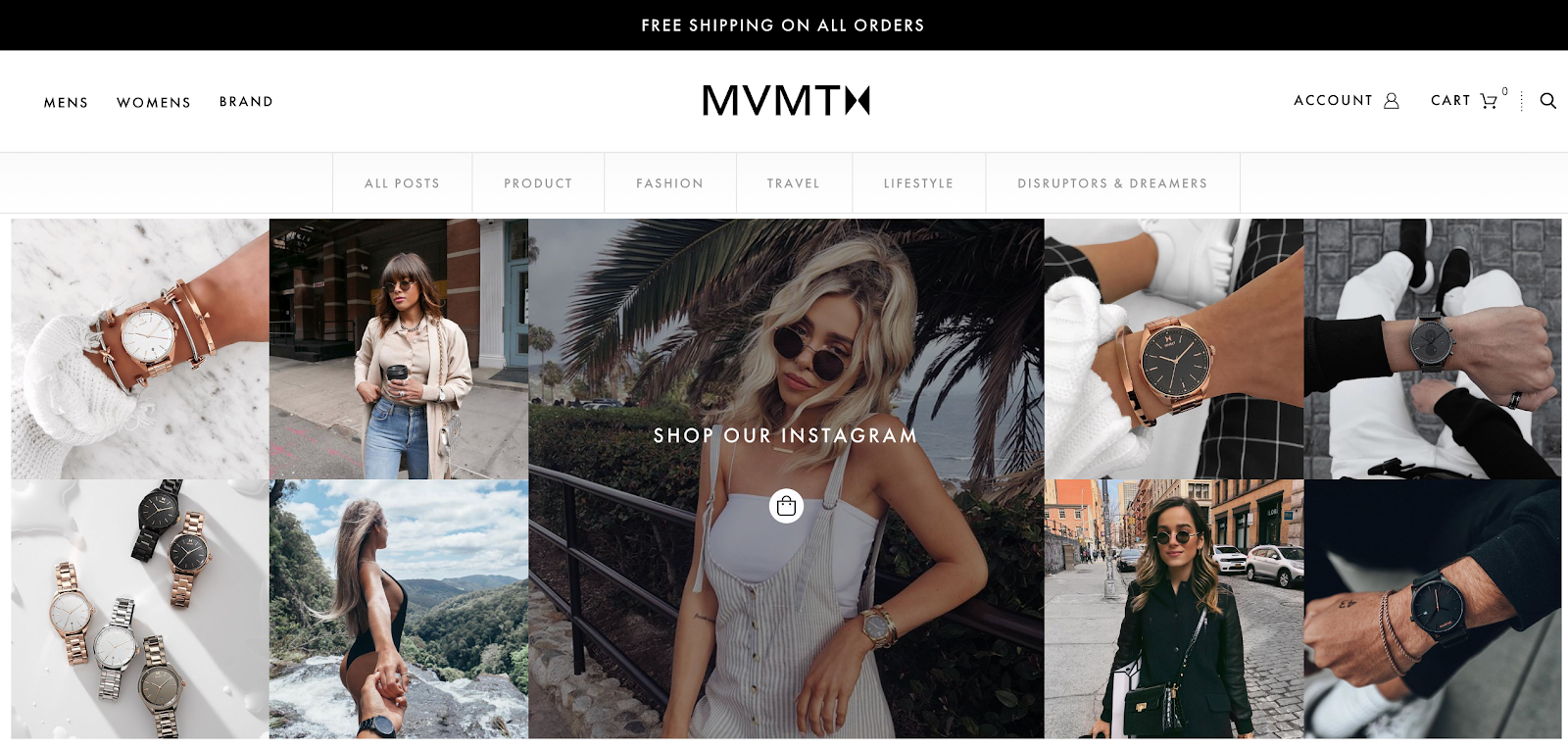
Once the user clicks on the image, they will be redirected to a page where they can shop the look featured in that image.
7. Death Wish Coffee

If there's one product that can afford to be fun and aggressive, it's coffee. And that's exactly what Death Wish Coffee strives to be. Take a look at its Stranger Things ft coffee blog post:
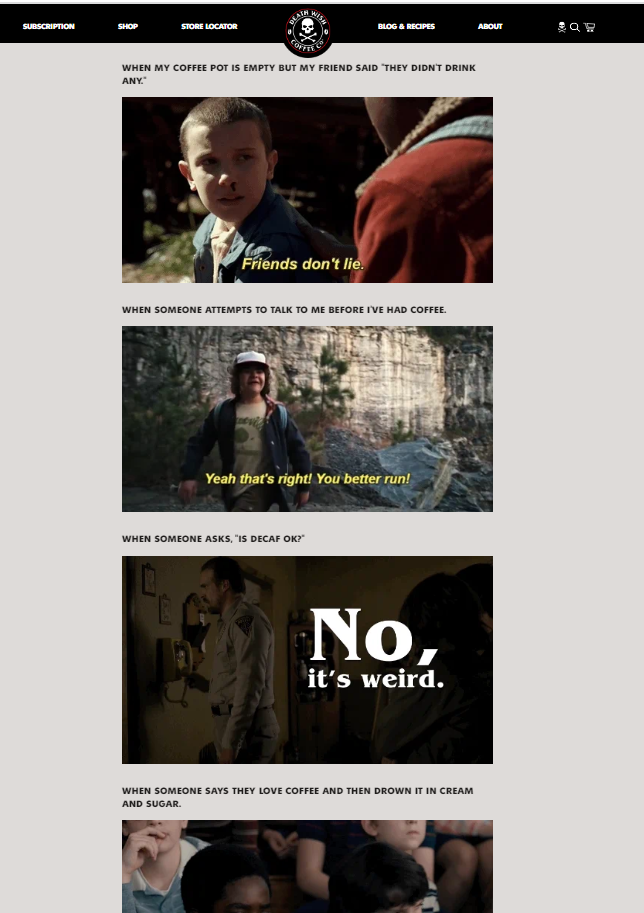
What differentiates the brand's blog posts is not its numerous coffee-related posts but pop-culture references that you might never have imagined relating to coffee posts. This makes sense because there's only so much you can write about coffee. So, the brand takes the fun route to attract readers and get them hooked. Here's how:
- The posts are updated and relevant to the seasonal trends: With Halloween having just gone by, you'll notice plenty of posts in and around the noble and versatile 'pumpkin:'

You will also find interesting blog posts that might be of interest to coffee drinkers (think: “Whole Bean vs. Ground Coffee” and “How to grind coffee beans for different brewers,” etc.) Sometimes, the brand also leverages the blog to share product launches as well as the latest company news.
- The content themes are neatly categorized: In terms of the content buckets, you've got all the relatable topics such as Recipes, Coffee, Lifestyle, The Biz, etc. The typography is clean, and the font size is easy to read. The genius, however, lies in this: As soon as a new customer lands on the page, you are greeted with a discount as shown below:

This strategy is a masterclass in lead capturing. Additionally, the blog section also automatically detects the visitor's location, making the experience as personalized as possible. Every blog post also has an email subscription call to action (CTA), as shown here, allowing prospective customers to sign up if they feel encouraged to do so:

The blogs are well-researched and follow proper internal linking to boost readability:

What you can take away from this example:
- Think about ways to leverage your blog content to capture leads. This strategy will help grow your email list organically.
- The blog is the perfect example of how to use conversion-friendly Shopify themes. The floating navigation bar at the top and the ideally-placed round logo demonstrates how versatile Shopify is if you use the right custom Shopify theme.
Pro tip: With Death Wish Coffee, the masterstroke lies in using larger-than-life images at the top of the blog as well as at strategic pit-stops within the blog to break up the content and prevent reader fatigue.
8. Tushy
Here's another Shopify blog example that will leave you chuckling. Tushy leverages humor as a content marketing tool and wins with every post! The blog is aptly titled "The Posterior" and showcases content around butt health, bidet, gut health, and more. From here, users are redirected to the brand's online store:

Tushy's use case is the ideal example of how brands can showcase their unique (and humorous) brand voice via their blogs:

While this strategy may not sit well with every kind of product/service, it works with lifestyle and personal care brands the most. Such is the brand's pull that users get onto the blog site whenever they have downright weird questions (think: 'Why Do We Have Butt Hair?' or 'This is Why Your Legs Fall Asleep on the Toilet') instead of asking Google in the incognito mode!
What you can take away from this example:
- If you want to engage people with your blog posts, add your brand's personality and (if possible) humor to your blogs. That said, in an effort to make the blog posts entertaining, don't forget to offer helpful content that your readers might be interested in. For example, in the case of Tushy, they have blog posts centered around healthy bathroom habits--from diet to cleanliness.
Pro tip: To connect better with the reader and boost engagement, play with the writing style. In Tushy's case, the writing is casual and informal, making the reader feel like they are conversing with their friend.
9. Brooklinen

Creating non-product-focused content is an art--one that Brooklinen is adept at. Brooklinen is a Shopify storefront that sells bedding, decor, bath, and loungewear items. Its blog section is an ideal example of how to build posts that cover wide-ranging topics related to a specific niche.

Instead of laser-focusing on writing about sheets (boring!), Brooklinen covers diverse topics (read: beauty, interior design, wellness, etc.) and subtly ties them to the brand's offering without over-selling their products.
The reason why Brooklinen's blog works is that the brand understands what motivates its target base and creates content to reflect the same:

What you can take away from this example:
- Oftentimes, you'll notice that well-received Shopify blogs create content that is aspirational--as Brooklinen does by encouraging users to 'buy into the Brooklinen lifestyle.'
- Brooklinen plays with a variety of content formats--from listicles to guides, and complements their blog posts with equally-beautiful imagery. To break the monotony, it makes sense to play with the content format and not limit yourself by solely writing about your products.
Pro tip: If you want to get into your audience's skin, step into their shoes and gauge their interests as well as aspirations to get more topic ideas to cover and create an unforgettable brand.
10. BestSelf

If you want to understand how to showcase different calls to action within your Shopify blog, take a look at BestSelf's blog. BestSelf is a platform that sells productivity tools such as journals, action pads, planners, intimacy decks, etc. The brand's CTA positioning across the blog page is the stuff of legends. For instance, BestSelf highlights an ebook it offers users in exchange for their email ID and name to build their contact list:

More interestingly, the brand you'll notice a small pop-up on the bottom-left corner which showcases a recently purchased item from users on the blog site. This kind of subtle product promotion can work wonders to encourage users to buy from your website:

In addition, the quality of blog topics as well as the research done, are both top-notch. You'll find useful content on productivity, personal development, journaling, relationships, and work-life balance, among others.
What you can take away from this example:
- Think of ways to integrate a CTA within your Shopify blog as strategically as BestSelf does. You can also consider having a lead magnet (such as the free “5 Days to Your Best Self” course in this case) to collect emails and grow your contact list.
Pro tip: The subtle pop-up signaling recent purchases from users is all the social proof blog readers need to go get their product of choice from the brand. Think of ways to integrate the same within your blog.
Wrapping Up
There you go. These were some of the best Shopify blog examples we have rounded up from the internet for you. As you'll notice, no blog is perfect and done to perfection. So, make sure to select ideas for your brand-specific blog and create one that entertains and educates your users at the same time. Consider these examples to get your creative juices flowing. Good luck!












.png)






